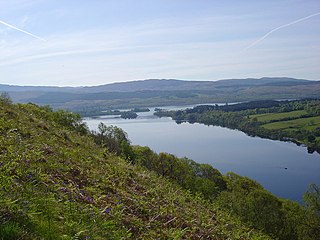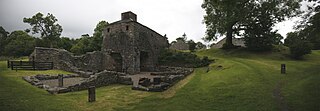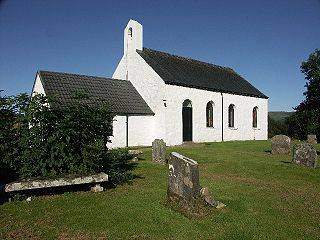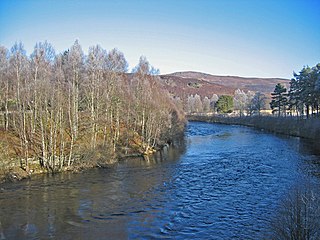History
In 1753 the Bonawe Iron Furnace was constructed on the north side of Taynuilt. [1] The furnace was of such strategic importance that in 1756 a military road was built to reach it, crossing the Pass of Brander and the Bridge of Awe. Despite flooding during construction, which swept away the partially built bridge, it was completed in 1779. [2] It was twenty years before the road was extended westward to Connel, and later still to Oban. [1]
The original bridge featured in the 1959 film 'The Bridal Path' starring George Cole and Gordon Jackson.
A reinforced concrete bridge was built in 1938 as a replacement for the old bridge. This is still in use today, carrying the A85 road from Oban to Dalmally over the River Awe.
The original bridge was destroyed in January 1992 following heavy floods. High winds had damaged the roof of the Inverawe Power Station, resulting in its temporary closure. Minimal water was drained from Loch Awe until the gates were opened to their maximum to relieve the level of Loch Awe and the Awe Barrage from overflowing. Two of the three arches of the old bridge were washed away, with one arch on the Taynuilt bank remaining, in part due to the deflection of the main flow by the small island upstream.
The course of the river has changed greatly since the 1992 floods. The island upstream now joins to the land on the Taynuilt bank in summer months when the river is low.

Argyll and Bute is one of 32 unitary council areas in Scotland and a lieutenancy area. The current lord-lieutenant for Argyll and Bute is Jane Margaret MacLeod. The administrative centre for the council area is in Lochgilphead at Kilmory Castle, a 19th-century Gothic Revival building and estate. The current council leader is Councillor Jim Lynch.

Seil is one of the Slate Islands, located on the east side of the Firth of Lorn, 7 miles southwest of Oban, in Scotland. Seil has been linked to the mainland by bridge since the late 18th century.

The A85 is a major road in Scotland. It runs east from Oban along the south bank of Loch Etive, through Lochawe and Tyndrum, Crianlarich, Lochearnhead, St Fillans and Crieff before passing through Perth, where it crosses the River Tay via Perth Bridge to Bridgend. Its name between Crieff and Perth is the Crieff Road. It then runs concurrently with the A90 to the Swallow Roundabout, before diverging to follow the Invergowrie Bypass, Riverside Avenue and Riverside Drive before terminating in Dundee city centre.

Loch Awe is a large body of freshwater in Argyll and Bute, Scottish Highlands. It has also given its name to a village on its banks, variously known as Loch Awe or Lochawe. There are islands within the loch such as Innis Chonnell and Inishail.

Loch Etive is a 30 km sea loch in Argyll and Bute, Scotland. It reaches the sea at Connel, 5 km north of Oban. It measures 31.6 km long and from 1.2 km to 1.6 km (1 mi) wide. Its depth varies greatly, up to a maximum of 150 m (490 ft).
The Callander and Oban Railway company was established with the intention of linking the sea port of Oban to the railway network. This involved a long line from Callander through wild and thinly populated terrain, and shortage of money meant that the line was opened in stages from 1866 to 1880.

Falls of Cruachan railway station is a railway station located at the foot of Ben Cruachan in Scotland. This station is on the Oban branch of the West Highland Line, originally part of the Callander and Oban Railway. It is sited between Taynuilt and Loch Awe, sited 52 miles 69 chains (85.1 km) from Callander via Glen Ogle. ScotRail manage the station and operate all services.

Bonawe is a village in Ardchattan Parish Argyll and Bute, Scotland opposite Taynuilt on the north shore of Loch Etive, most famous for the shipping firm J & A Gardener's Bonawe Quarry - now owned by Breedon Aggregates Scotland Ltd. Bonawe is primarily a linear settlement along on the B845 road and the coast. The iron furnace is at Bonawe in Glenorchy & Inishail Parish across Loch Etive nr Taynuilt in Muckairn Parish.
Dalmally is a village in Argyll and Bute, Scotland. It is near the A85 road and is served by Dalmally railway station.

Taynuilt is a large village in Argyll and Bute, Scotland located at the western entrance to the narrow Pass of Brander.

The Carron is a river in central Scotland, rising in the Campsie Fells and flowing along Strathcarron into the Firth of Forth. It has given its name to several locations in Stirlingshire, as well as a type of cannon, a line of bathtubs, two warships, and an island in the Southern Hemisphere.

The River Conon is a river in the Highlands of Scotland. It begins at Loch Luichart, and flows in a south-easterly direction to be joined by the River Meig at Scatwell before passing through Loch Achonachie. It is joined by the Black Water at Moy Bridge, and the River Orrin at Urray, before flowing past Conon Bridge and into the Cromarty Firth.
National Cycle Route 78 runs from Campbeltown to Inverness. It was officially launched as the Caledonia Way in 2016 as part of the wider redevelopment of Scotland's cycle network. It runs from the Kintyre peninsula to the Great Glen and the route varies from on road to traffic-free forest trails and canal paths.

Dalavich Church is a kirk (church) in the settlement of Dalavich in the Lorne district of Argyll in Scotland, belonging to the Church of Scotland. It is situated 14.0 miles (22.5 km) south of Taynuilt and 7.0 miles (11.3 km) south–west of Kilchrenan on the B845 road on the western shore of Loch Awe.

The Falls of Cruachan derailment occurred on 6 June 2010 on the West Highland Line in Scotland, when a passenger train travelling between Glasgow and Oban hit boulders on the line and derailed near Falls of Cruachan railway station, after a landslide. There was a small fire and one carriage was left in a precarious position on the 50-foot-high (15-metre) embankment. Sixty passengers were evacuated, some with minor injuries; eight of those were hospitalised as a precaution. However, no people were killed. In addition to blocking the line, the incident also caused the closure of the A85 road below the rail line. Both road and rail were closed for a week.

The River Awe is a short river in Argyll and Bute, Southwest Highlands of Scotland by which the freshwater Loch Awe empties into Loch Etive, a sea loch. The river flows from a barrage which stretches across the end of a deep arm of the loch which protrudes northwestward through the Pass of Brander from the northeast–southwest aligned Loch Awe. The river is accompanied for much of its length both by the railway from Glasgow to Oban and by the A85 road both of which cross the river halfway along its length. The Awe is also crossed by a minor road bridge and a foot bridge.

The River Moriston is a river in Inverness-shire, Scotland. It flows broadly east-north-east from the outfall of the dam at Loch Cluanie to Loch Ness. Its waters and those of its tributaries have been harnessed to generate hydro-electric power.

The Pass of Brander is a mountain pass in the Highlands of Scotland, where the main railway and road to Oban makes its way between Cruachan, a 3,689-foot (1,124 m) mountain, and Loch Awe.
The Inverarnan Canal was a short length of canal terminating at Garbal, close to the hamlet of Inverarnan, Scotland. This waterway once linked the old coaching inn, now the Drovers Inn, at Inverarnan, on the Allt Arnan Burn to the River Falloch and passengers could continue southward to Loch Lomond and finally to Balloch. From Inverarnan stagecoaches ran to various destinations in the north of Scotland.














